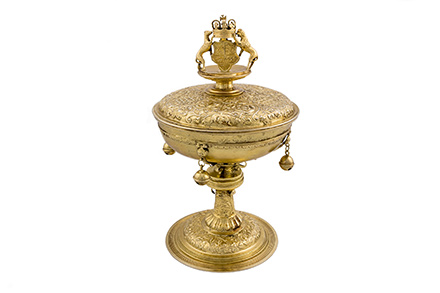Archive, Library & Collections
The Company possesses an exceptional inheritance of paintings, silver and other historic artefacts, carefully preserved through hazards as traumatic as the Fire of London and the Second World War. The Holbein painting of Henry VIII and the Barber-Surgeons, celebrating the union of the Barbers and Surgeons in 1540, is the earliest of many works directly linked to the life of the Company. For more information please click here.
Portraits of Masters include a representation of Edward Arris performing an anatomical dissection in 1651, and a painting of Charles Bernard, Serjeant-Surgeon to Queen Anne, whose work for the Navy is reflected in its picture frame decorated with sea shells. Foremost amongst the silver are the Grace Cup presented by Henry VIII and the Royal Oak Cup given by Charles II. Cups, tankards, rose-water dishes and ewers represent fine English silverware of the seventeenth century and the collection continues through Georgian tableware to contemporary designs. Other historic artefacts include a case of surgical instruments from the time of Henry VIII and a remarkable collection of barbers’ bowls, the earliest being a Lambeth Delftware bowl of around 1680.


The archives include a fine series of Charters and Court minutes from 1462 to the present. These document the life of the Company and the generosity of benefactors who continue to enhance its historic collections. The Barbers’ library provides further resources for research. The original library was sold shortly after the surgeons separated in 1745 to form their own Company. Since 1977 some one thousand books on surgery, anatomy and related topics from 1540 to 1745, mostly original texts, have been collected; as well as materials on barbery up to the early twentieth century, barber-surgeons, surgeons and the Royal Navy, surgical instruments and the Mary Rose. It also contains early herbals, biographies of members of the Company and leading medical practitioners, and also works on London hospitals and on the City and its livery companies. The library is a highly specialised if varied collection, available for use on application to the archivist. The collection provides a basis for research on the history of anatomy, surgery, physic and barbery, and on their context both within and without the City.



